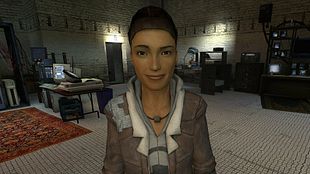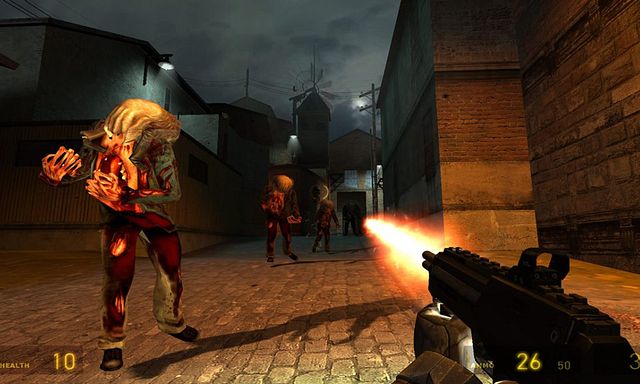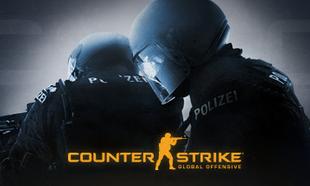The sequel is often the trickiest thing to nail in the creative arts, but 'Half-Life 2' makes it look easy.
'Half-Life 2' came 6 years after the original 'Half-Life' transformed the fortunes of PC gaming almost overnight, and doubled down on what made the original game great.
Released in November 2004, 'Half-Life 2' has a legitimate claim to being one of the best sequels in any art form.
Describing exactly why 'Half-Life 2' is so good is like describing breathing, but we'll give it a shot.
In the 18 years since release, 'Half-Life 2' has become the template for other games to follow - in all regards.
Valve are innovators writ large, and 'Half-Life 2' is them in top form.
All Steamed Up
'Half-Life 2', and Valve games at large, are masterful at letting players fill in the gaps of the story.
Valve are industry-best at environmental storytelling, and players can have as little or as much agency as they like in trying to put the pieces together.
'Elden Ring' showed earlier this year that giving players the choice to either blitz through the game or drink in the lore is a major part of the appeal, and it owes a lot to 'Half-Life 2' in that regard.
The story of 'Half-Life 2' unfolds right in front of the players eyes, and if players are so inclined, they can jump on a desk or fire their weapon while a character is giving exposition.
The game doesn't grind the pacing to a halt to show off a fancy pre-rendered cutscene, and the story is told right in front of you.
It is a liberating experience, and just one of the many ways 'Half-Life 2' set the standard for gaming in general.
Outside the peerless gameplay and world design, 'Half-Life 2' changed the gaming landscape in another way: it helped pave the way for Steam.
In the early 2000s, digital storefronts became a part of the internet experience, but before then, players would have to go to their local electronics retailer to pick up the latest hit game.
Valve CEO Gabe Newell saw a gap in the market to create an iTunes-style storefront for games, but to sell the idea, he needed a blockbuster to make it worthwhile.
That "worthwhile" was Steam, and there is simply no understating how much of a transformative effect Steam has had on the gaming industry.
Gabe Newell saw where the entertainment industry was heading with regards to distribution, and for that reason alone, 'Half-Life 2', deserves an entry in our hall of fame.
Every new hot product in the world of electronics or software needs a killer app to help get people on board, and 'Half-Life 2' helped sell the general public on Steam and digital storefronts for their games.
The traditional brick and mortar shop has adapted and still exists in 2022, but the Valve revolution helped usher in the digital era.
For that reason alone, 'Half-Life 2' will be remembered as perhaps the first game that was sold day-and-date alongside a traditional retail release, but there's another factor at play: the game is simply tremendous and brimming with innovation.
Defying Gravity
The opening level is a masterclass in "show, don't tell" game design.
The opening train ride into City 17 gives you a taste of the world you spend the next 10 hours or so inhibiting and liberating.
Stepping off the platform to see the Doctor Breen video message is ripped straight from the pages of Orwell, and the decrypt apartment blocks and sense of hopelessness in the face of an authoritarian regime are taken from the annals of world history.
By putting players in the shoes of Gordon Freeman, you undertake a very personal journey with him, and the choice to not make him speak grants him that much more power in the minds of the player.
The Combine taking over the earth would be the plot of an undoubtedly very exciting generic first-person shooter, but in the lore of 'Half-Life', the war against The Combine was an abject failure for humanity.
By letting the players fill in the gaps in their own minds and the game becomes richer when each gamer can draw up their version of events in their own minds.
In 'Duke Nukem', the hero rattles off one-liners while dispatching of enemies, and the player is given an implicit invitation to project themself onto Gordon Freeman.
We personally play Gordon Freeman as an introvert scientist who happens to be skilled with a gun, but you can just as easily give him the dry wit of a Bruce Willis action hero if you want.
Gordon Freeman is the face of the 'Half-Life' franchise, but players can truly project themselves onto him, making the experience a deeply personal one.
The player never leaves Freeman's perspective over the game, and you're with him from the moment you step off the train until the explosive cliffhanger.
The supporting cast of 'Half-Life 2' helps sell the stakes and drama in the game world, with the game taking place in the aftermath of a devastating invasion by the Combine that has left the earth in ruins.
The facial animations on Alyx, nearly 20 years later, still represent the high watermark for character animation in a game.
For 2004, Alyx squinting when you shine a light in her face was impressive, in 2022, it's extraordinary to think how they pulled that off.

The promise of 'Half-Life 2' was that other developers would copy what Valve did in terms of interactivity, animation and design, but developers took the wrong lessons.
The other way in which 'Half-Life 2' innovated was it's aforementioned physics system, and the game rightfully made a big song and dance about it.
The gravity gun is a genuinely phenomenal achievement in game design, and the game gives it the gravitas it deserves, rightfully making it the star of the show.
What other developers forgot to take into account was that the gravity gun was one of 25 things 'Half-Life 2' did perfectly, and it put just as much love and affection into making the game world believable, the characters relatable and the gameplay fun.
It is a shame that Valve are only interested in making hats for 'Team Fortress 2' or voice packs for 'DOTA 2', because there are simply very few developers like Valve in the gaming industry.
Every industry needs innovators to push it forward as an artform, and Valve in their prime made it look so effortless.
Ravenholm Rock
A discussion of 'Half-Life 2' is not complete without discussing the level set in the mining town of Ravenholm.
The trip through Ravenholm comes at around the halfway point to the game, and just after you have a nice breather level meeting your old friends at Black Mesa East.
If you know what was going to happen next, you'd be well-advised to stay put.
Ravenholm, is without any hyperbole, the most terrifying level in video game history.
There is an impeccable sense of dread, and the level of paranoia is more potent than any horror film.
The first-person perspective works wonders here, as you are tasked with making your way through the town.
Ravenholm is swarming with zombies and headcrabs, and trying to guess where they are at any given time is half the fun of the level.
Ravenholm is the best haunted house ever, and no matter how many times you play through it, you're always on edge, waiting for a poison headcrab to ambush you.
And of course, speedrunners are able to beat the level in 90 seconds.
Sometimes, the best horror moments in games come from games that aren't necessarily horror.
Vault 22 from 'Fallout: New Vegas', the aftermath of the white phosphorus incident in 'Spec Ops: The Line' or the Scarecrow moments in 'Batman: Arkham Asylum' put chills down your spine, but Ravenholm holds a legitimate claim to being the most terrifying level in video game history.
It also happens to be one of the best.
Ravenholm is Valve in full showboating mode, with everything the player has learned so far coming into play, with the gravity gun becoming the star of the show as players must navigate the zombie-infested streets.
Players are cheered on by the wonderfully loopy Father Grigori, a shotgun-wielding priest who has jury-rigged the town with booby traps.
When you stop to drink in the atmosphere and hear the distant howls of zombies in the distance, Ravenholm is representative of the promise of video games as an artform: it can transport you to another world and make you the hero of the story.
Unforeseen Consequences
The level comes at the halfway point of the game, and gradually escalates from there, with a memorable sequence in a coastal prison springing to mind, until the show-stopping finale.
The upgraded gravity gun allowing you to fling enemies around with abandon is a power trip on a par with using the BFG in the original 'Doom', until the game suddenly comes to a halt.
G-Man steps out of a pocket dimension and ends the game on a cliffhanger.
'Half-Life 2' was also ambitious in another way: it tried to tell the story across multiple chapters.
Of course, 'The Walking Dead' perfected this technique in the 2010s, but the crucial difference is Telltale knew how to finish and release a game.
A 2-year delay meant that players had to wait until 2006 to pick up where the action left off in 'Half-Life 2: Episode 1' and October 2007 saw the release of 'Half-Life 2: Episode 2' as part of the release of 'The Orange Box'.
That was the best part of 3 years waiting for the game to actually bloody finish, until the game goes and ends on a cliffhanger.
Fans of TV will be aware of their favourite show being left on an unresolved cliffhanger, and sometimes these cliffhangers get resolved like in 'Twin Peaks', but often times we don't get an answer as to what happened next.
We never did find out what happened after the end of 'Half-Life 2: Episode 2', we don't know if Gordon Freeman and the gang were successful in halting the Combine threat, and saddest of all, we never figured out if Valve could indeed count to 3.
The 'Half-Life 2' saga being left unresolved is strangely fitting in a way, knowing that Gordon and the G-Man are destined to be two sides of a coin forever, partaking in a cosmic ballet and battle of the wills.
The best artists in music history never released more than two albums like Joy Division or Amy Winehouse, and that leaves their legacy that much stronger.
Of course, Valve still exist to this very day as a wildly successful video game distributor that are more focused on making obscene amounts of money.
One of these days, we pray that Valve becomes bored of making rivers of money and finishing the 'Half-Life' story.
2020's 'Half-Life: Alyx' is an indicator that Valve are still interested in revisiting the property, and with the game being a killer app for VR headsets, the results are surely justifiable for Valve to finish the Gordon Freeman story.
If not for our sake, at least for the sake of the garden gnome we sent up in a rocket at the end of 'Half-Life 2: Episode 2'.











































































